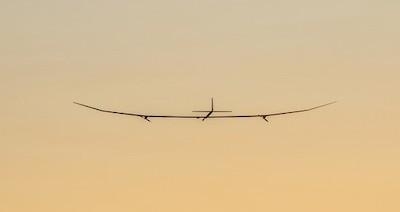Persistent High Altitude Solar Aircraft (PHASA-35) Has The Potential To Stay Airborne For A Year
PHASA-35, a 115-foot wingspan solar-electric aircraft, has successfully completed its maiden flight. The landmark flight paves the way to this new aircraft closing the gap between aircraft and satellite technology.

PHASA-35 has been designed, built and now flown in less than two years as part of a collaboration between ourselves and Prismatic Ltd, which we agreed to acquire last year. Designed to operate unmanned in the stratosphere, above the weather and conventional air traffic, PHASA-35 offers a persistent and affordable alternative to satellites combined with the flexibility of an aircraft, which could be used for a range of valuable applications including forest fire detection and maritime surveillance.
Sponsored by the U.K.’s Defense Science and Technology Laboratory (DSTL) and Australian Defense Science and Technology Group (DSTG), the successful flight trials took place at the Royal Australian Air Force (RAAF) Woomera Test Range in South Australia.
The trials marked the first fully integrated flight test of the PHASA-35 system, delivering rapid proof of capability from design to flight in just 20 months. They are the culmination of efforts from a collaborative team of British experts from Prismatic in Hampshire - where two full-sized concept aircraft were built last year - working alongside our engineers in Lancashire, where the aircraft underwent further integration testing prior to flight trials.
As a High Altitude Long Endurance (HALE) vehicle, PHASA-35 is powered by the Sun during the day and by batteries overnight. The long-life battery and highly efficient solar technology could allow the aircraft to maintain flight for up to a year operating in the stratosphere, the upper regions of the Earth’s atmosphere.
PHASA-35 is designed to provide a persistent, stable platform for monitoring, surveillance, communications and security applications. When connected to other technologies and assets, it will provide both military and commercial customers with capabilities that are not currently available from existing air and space platforms. The Unmanned Air Vehicle also has the potential to be used in the delivery of communications networks including 5G, as well as provide other services, such as disaster relief and border protection, at a fraction of the cost of satellites.
"This is an outstanding early result that demonstrates the pace that can be achieved when we bring the best of British capability together," said Ian Muldowney, Engineering Director for BAE Systems. "To go from design to flight in less than two years shows that we can rise to the challenge the U.K. Government has set industry to deliver a Future Combat Air System within the next decade.”
The acquisition of Prismatic forms part of the company’s strategy to develop breakthrough technologies, making bolt-on acquisitions where they complement existing capabilities and provide an opportunity to accelerate technology development in key areas.
Further flight trials are scheduled for later this year, with the possibility that the aircraft could enter initial operations with customers within 12 months of the flight trials programme completion.
(Image provided with BAE Systems news release)
 ANN's Daily Aero-Term (05.09.24): Hold Procedure
ANN's Daily Aero-Term (05.09.24): Hold Procedure ANN's Daily Aero-Term (05.06.24): Altitude Readout
ANN's Daily Aero-Term (05.06.24): Altitude Readout ANN's Daily Aero-Linx (05.06.24)
ANN's Daily Aero-Linx (05.06.24) Airborne-NextGen 05.07.24: AI-Piloted F-16, AgEagle, 1st 2 WorldView Sats
Airborne-NextGen 05.07.24: AI-Piloted F-16, AgEagle, 1st 2 WorldView Sats Aero-News: Quote of the Day (05.07.24)
Aero-News: Quote of the Day (05.07.24)



